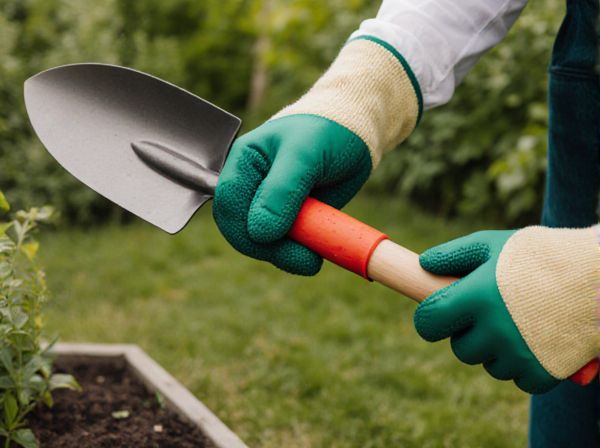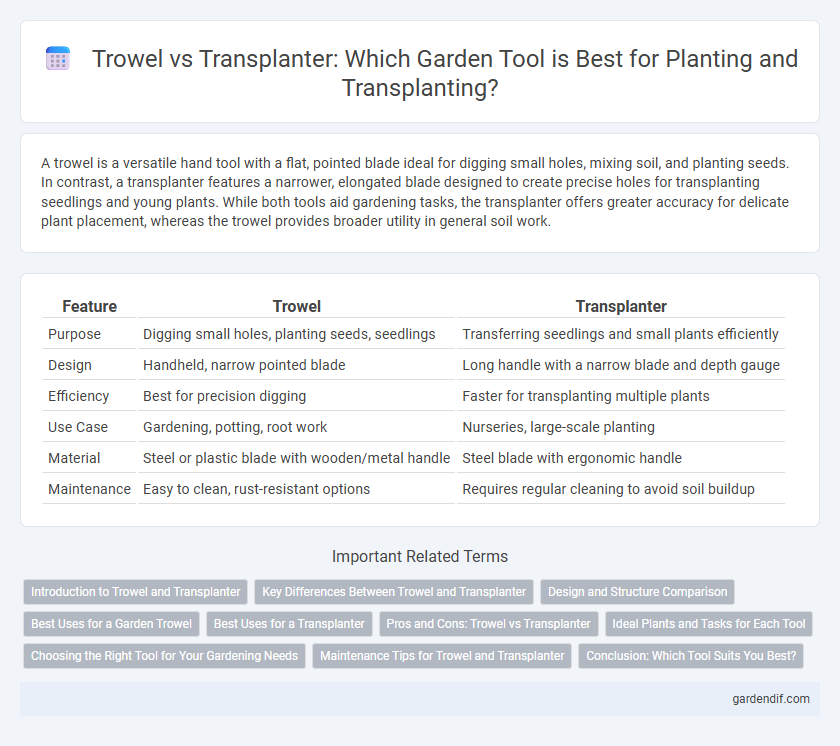
Trowel vs transplanter Illustration
A trowel is a versatile hand tool with a flat, pointed blade ideal for digging small holes, mixing soil, and planting seeds. In contrast, a transplanter features a narrower, elongated blade designed to create precise holes for transplanting seedlings and young plants. While both tools aid gardening tasks, the transplanter offers greater accuracy for delicate plant placement, whereas the trowel provides broader utility in general soil work.
Table of Comparison
| Feature | Trowel | Transplanter |
|---|---|---|
| Purpose | Digging small holes, planting seeds, seedlings | Transferring seedlings and small plants efficiently |
| Design | Handheld, narrow pointed blade | Long handle with a narrow blade and depth gauge |
| Efficiency | Best for precision digging | Faster for transplanting multiple plants |
| Use Case | Gardening, potting, root work | Nurseries, large-scale planting |
| Material | Steel or plastic blade with wooden/metal handle | Steel blade with ergonomic handle |
| Maintenance | Easy to clean, rust-resistant options | Requires regular cleaning to avoid soil buildup |
Introduction to Trowel and Transplanter
A trowel is a small hand tool with a pointed, scoop-shaped metal blade used primarily for digging, planting, and weeding in gardening. A transplanter, resembling a narrow trowel, features measurement markings on the blade to ensure precise planting depth for seedlings and bulbs. Both tools are essential for detailed garden work, with the transplanter providing added accuracy for transplanting tasks.
Key Differences Between Trowel and Transplanter
A trowel is a small hand tool with a pointed, scoop-shaped metal blade used primarily for digging, planting, and scooping soil in gardening tasks. In contrast, a transplanter features a longer, narrower blade designed specifically for digging precise holes and transplanting seedlings or small plants with minimal root disturbance. Key differences include blade shape, size, and purpose, with the trowel offering versatility and the transplanter providing precision for delicate planting operations.
Design and Structure Comparison
Trowels feature a narrow, pointed blade ideal for digging small holes and precise soil manipulation, while transplanters have a longer, narrower blade designed to easily reach deeper soil layers for transplanting seedlings. The ergonomic handle of a trowel offers better control for detailed tasks, whereas transplanters possess a sturdier build to handle tougher soil conditions. Both tools prioritize durability and comfort, but the transplanter's structure supports deeper planting needs compared to the compact design of the trowel.
Best Uses for a Garden Trowel
A garden trowel is best used for precise tasks such as digging small holes for planting bulbs, transplanting seedlings, and mixing soil or fertilizer in confined spaces. Its narrow, pointed blade allows for easy maneuvering around roots and delicate plants, making it ideal for detailed garden work. Compared to a transplanter, which is designed for deeper soil displacement, a trowel excels in versatility for everyday gardening tasks requiring control and accuracy.
Best Uses for a Transplanter
A transplanter excels in precise seedling placement due to its long, narrow blade that allows deep, straight holes in compact soil, ideal for root-sensitive plants. Best used in vegetable gardening, it efficiently handles tasks like transplanting tomato seedlings and pepper plants, minimizing root disturbance. Compared to a trowel, the transplanter's design ensures better aeration and soil penetration, promoting healthier plant establishment.
Pros and Cons: Trowel vs Transplanter
A trowel offers precise control for digging small holes and transplanting seedlings, making it ideal for detailed garden work and tight spaces, but its limited size restricts efficiency in larger planting tasks. A transplanter features a longer handle and narrow blade, facilitating deeper planting and reducing strain during repetitive use, though it may lack the versatility of a trowel for intricate soil manipulation. Choosing between a trowel and transplanter depends on the scale of gardening, with trowels suited for delicate, small-scale jobs and transplanters better for medium-sized transplanting requiring ergonomic design.
Ideal Plants and Tasks for Each Tool
The trowel is ideal for planting small annuals, succulents, and herbs, as it excels in digging, mixing soil, and transplanting seedlings in confined spaces. A transplanter, with its narrow blade and depth markings, is perfect for relocating young plants, bulbs, and small shrubs, ensuring precise planting depths and minimal root disturbance. Both tools serve unique roles, with the trowel suited for general soil work and the transplanter designed for careful root handling and accurate planting depth.
Choosing the Right Tool for Your Gardening Needs
Selecting the right gardening tool depends on the task and soil type; a trowel excels in digging small holes and transplanting seedlings in compact soil, while a transplanter with its narrow blade is ideal for precision planting in tight spaces. Trowels often feature a broader blade that allows for scooping and mixing soil, making them versatile for general gardening purposes. Understanding the specific requirements of your plants and garden layout ensures efficient use of either a trowel or transplanter, optimizing plant health and growth.
Maintenance Tips for Trowel and Transplanter
Regularly clean trowels and transplanters with warm, soapy water to remove soil and prevent rust buildup. Sharpen blades of transplanters periodically using a whetstone to ensure efficient cutting and transplanting. Store tools in a dry place and apply a light coat of oil to metal parts to extend their lifespan and maintain optimal performance.
Conclusion: Which Tool Suits You Best?
Choosing between a trowel and a transplanter depends on your gardening needs and plant types. A trowel offers versatility for digging, planting, and weeding in small spaces, making it ideal for container gardening and general use. Transplanters feature a narrower blade and depth markings, providing precision for transplanting seedlings and root-bound plants with minimal disturbance.
Trowel vs transplanter Infographic

 gardendif.com
gardendif.com